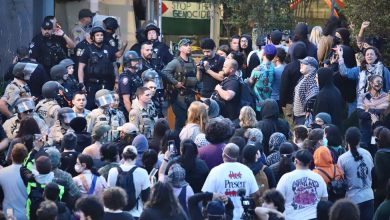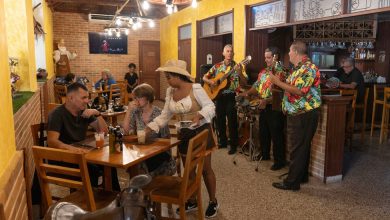A ‘Fair Fares’ Program So Exclusive, Barely Anyone Can Qualify For It

Derek Jiminez relies on the New York City subway to get to a maintenance job that pays about $1,000 a month. The fare adds up fast, but since he got a half-priced MetroCard two years ago, his checks have stretched a little further.
With the extra money, he can afford things he couldn’t before, like a pair of guitars he got on sale. But mostly, he said, he saves what he can.
“I hold onto it for now, for rainy days,” said Mr. Jiminez, 56, who lives in East Harlem. “The economy is really hurting.”
Mr. Jiminez is among 260,000 riders enrolled in the city’s Fair Fares program, which subsidizes public transit fares for New Yorkers whose income falls below the federal poverty line — about $28,000 a year for a family of four. Since the program started in April 2019, enrollment has grown nearly sevenfold.
Many elected officials, advocates and the leader of the transit agency that operates the subway have been pressing the new mayor, Eric Adams, to provide more financing for the program and expand eligibility for it, arguing that many more riders could benefit.
New York, where it generally costs $2.75 to ride the subway, operates one of the most expensive major public transit systems in the country, and despite popularity of the reduced fare program, it only reaches the poorest riders. Many working-class commuters, who rely on public transit every day, do not qualify and must dig deep to be able to ride.
Of the American cities that offer discounted fares, New York has among the strictest income eligibility rules for its program, requiring applicants to be at or below the federal poverty level.
Roughly 900,000 adult New Yorkers live in poverty, according to census data.
“It is imperative that public transportation be accessible, affordable, and equitable for all New Yorkers,” Adrienne Adams, the City Council speaker, said in a statement on Sunday, as she called on the mayor to double the program’s funding, from $53 million to $106 million. The city initially promised that amount when the program began, but it was halved when the pandemic triggered a financial crisis.
Mr. Adams agreed on Monday to raise the funding, but only to $75 million. “Since its inception, Fair Fares has proven to be a transformative program for so many New Yorkers struggling to get by,” Mr. Adams said in a joint statement with the speaker.
Though Ms. Adams said that she was pleased with the additional funds, she added that the Council would continue to push for more money.
The State of New York City’s Subway
- Perspectives From the Platform: Times reporters visited three stations to see where subway riders have returned, and where they haven’t.
- Subway Killing: The high-profile death of a woman who was pushed onto the tracks poses a test for Mayor Eric Adams.
- A Long-Delayed Subway: Residents of East Harlem have been waiting almost a century for new stations. Some aren’t sure they’ll be built.
- M.T.A.’s Uncertain Future: While ridership has crept back up, there’s a growing consensus that it may never return to prepandemic levels.
- Sharing the Train Again: Our photographer spent a year riding the subway amid the city’s fitful recovery. Here’s what she saw.
Discounted MetroCards, which can be used on the subway and on buses, can be a financial lifeline in New York, where for many residents public transit is a basic necessity.
“People are literally choosing between having a meal and paying for a MetroCard,” said Danny Pearlstein, a spokesman for the Riders Alliance, an advocacy group.
Felix Cepeda, 41, makes a modest living, in part by doing community outreach for an immigrant advocacy group. He sleeps at his girlfriend’s apartment in East Harlem or at a sister’s home in the Bronx. He said he used to jump turnstiles before enrolling in Fair Fares last fall.
“It’s very hard to be putting money that I don’t have to spend on the card,” Mr. Cepeda said. “That is money I can use for food.”
Janno Lieber, the M.T.A.’s chairman and chief executive, said expanding the subsidized MetroCard program could help the transit system lure riders back as it struggles to emerge from the pandemic.
City leaders have “talked about all these different priorities of addressing poverty and equity,” Mr. Lieber said. “They already made a commitment to this. They just need to fund it at a level that makes it real.”
The agency’s finances, which have been battered by the pandemic-era loss of ridership, have been stabilized by infusions of federal aid, as well as millions in state money allocated by Gov. Kathy Hochul to help delay planned fare hikes. But the M.T.A. still faces a $1.4 billion deficit in 2025.
Mr. Adams’s first proposed budget is due Wednesday and transit advocates say the city can afford to spend more money on the subsidized fare program. The city’s current spending plan is $102.8 billion.
“For a relatively small percentage of the city’s budget, it can make a very big difference,” Mr. Pearlstein said.
A survey released on Monday by the Community Service Society, an antipoverty nonprofit, found that many low-income New Yorkers were not aware that the Fair Fares program even existed. The report also found that many poorer people, especially those who identify as Latino or Black, struggled to pay for subway or bus fares.
Beyond spending more money on the program, the group is urging officials to raise the income threshold for applicants and to promote Fair Fares more aggressively. Today, some of that outreach takes place through advertisements in subways, buses and some shops.
“We’re using a poverty rate that applies to Mississippi and to Manhattan, which is crazy,” said David Jones, president and chief executive of the Community Service Society and a member of the M.T.A. board. “What may seem like a bonanza in Mississippi can barely pay the rent in the city of New York.”
Among larger American cities, New York’s transit system is the third least affordable by percentage of income spent on fares, behind only Los Angeles and Miami, according to a recent assessment by ValuePenguin, a consumer research website.
At least 15 cities in the United States offer reduced-fare programs for low-income transit riders, according to a study published last summer in Transportation Research Record, an academic journal.
Low-income riders on the Los Angeles County Metropolitan Transportation Authority system can receive $6 off the cost of $12.50 weekly passes and $24 off the cost of $50 monthly passes through the Low-Income Fare is Easy program. Boston offers a more limited program for low-income riders who are 18 to 25 years old.
In New York, the Fair Fares discount can be applied to weekly and monthly unlimited ride cards, reducing the price of a weekly pass from $33 to $16.50 and a monthly card from $127 to $63.50.
The 50 percent discount is also available for the Access-A-Ride program, which offers door-to-door transportation within the city to people who can’t use public transit because of a physical or mental disability.
Early on in the pandemic, some transit systems, including the M.T.A., temporarily stopped charging bus fare to limit contact between riders and drivers. In Boston, officials have decided to make at least three bus routes free through February 2024, in hopes of making the system more equitable.
The Fair Fares program was created after years of aggressive lobbying from transit advocates and anti-poverty groups, who argued that it would help the city address inequality.
Mr. Adams’s predecessor, Bill de Blasio, was initially cool to the idea because he did not want to provide more money to the M.T.A. than the city already did.
He finally relented under pressure from the City Council, but the program’s rollout was disorganized: it failed to start on time, people were confused about how to apply and it was not always clear who could qualify or what types of MetroCards would be offered at half price.
“A huge share of the population is low income, providing service jobs and ensuring, essentially, that our communities continue to be able to function. And they continue to ride transit in much higher numbers,” said Yonah Freemark, a senior research associate at the Urban Institute. “I think we have to see transit as this essential provision for people of lower incomes.”



